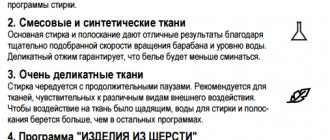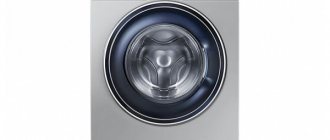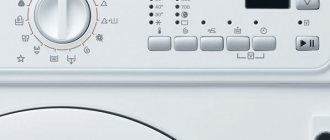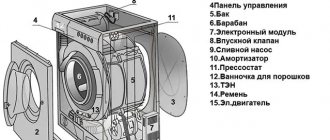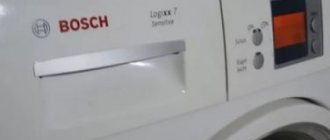How do foreign objects get into the washing machine?
To get an object that is stuck in a tank, you need to understand how it got there:
- Usually small items fall into the drum from your pockets if you forget to check them.
- Also, poorly sewn buttons and other decor may come off from clothing.
- Paper, coins, chains, lighters, and flash drives often remain in pockets. Sometimes users even forget to take out their phone. These items usually remain in the tank, some go into the drain system and end up in the drain filter.
- The greatest danger is the underwire from the bra. This element of the bra is thin and flexible, so it easily gets under the drum through the holes and remains there, creating noise and grinding.
- Large debris and small items such as a sock or handkerchief are unlikely to get into the tub, but they can be caught in the rubber cuff - and if washed too vigorously, they will also go inside the tub.
- Small items can go down into the tank through the detergent intake.
Important! Often the reason that a foreign object is stuck in the SMA is a large gap between the tank body and the drum.
Everything that falls into the tank goes this way:
- sinks to the very bottom of the tank;
- gets stuck in the tank;
- may wrap around the shaft.
Why did a foreign object get into the drum?
The reasons for foreign objects getting into the washing machine drum are as follows:
- Poorly sewn buttons that come off during intense turning. Often they penetrate from the drum into the filter or tank.
- Unchecked trouser pockets, in which flash drives, keys, coins, lighters, and paper bills are often stored.
- Socks and small scarves are usually washed randomly, without a special bag, so they fall under the sealing rubber band, and from there, during the intensive rotation of the main pile of laundry, they are pressed into the tank.
- The most dangerous thing is a bra underwire. It is flexible, curved, thin and easily fits even into small holes in the drum, creating a grinding noise.
In older washing machines with leaky seals and loose drums, small objects are more likely to get inside the tank.
When to call a specialist?
Three situations are possible:
- A thin object, such as a bra wire, got stuck in one of the holes in the drum. To remove it, pinch the accessible end with pliers and gently pull, being careful not to break it. Of course, such a task can be completed without a specialist.
- The loss is not visible, but you are sure it is in the typewriter. Small things like a chain, screw, or coin may end up in the drain filter. It’s not difficult to get them yourself - you don’t need a master either.
- If you hear a clanging noise as the machine is running, as if metal is rubbing against metal, a foreign object may have gotten underneath the drum. At this point you need to call a specialist. A metallic sound may also indicate wear or malfunction of a part. It is difficult to diagnose a breakdown without the help of a specialist.
Frame wire for a bra: what is it made of and what harm does it cause?
At first glance, if you compare the size of the machine and the linen accessories, it seems that it is unlikely to do any harm. But the point is not in size, but in the material from which the bone is made.
Most often, frames or bones for linen are made of metal or coated steel.
Getting stuck in the tank of the machine, such corsetry parts begin to rust, stain water and washable items, and can tear linen. And these are even the easiest of troubles. Much worse is that a sharp metal bone can easily pierce the washing machine tank, damage the coating of the heating element, tear the cuff or drain pipe.
If the fittings are made of plastic, then they are less destructive.
Although, when a plastic bone has fallen deep into the washing machine, it can also make a mess. For example, pierce the same drain pipe or slip into the pump and disable it.
Plastic and iron bones in the washing machine: what's the catch?
Plastic bones inside the machine (for example, Indesit IWSC 51052 A UA) are the most harmless option, because they cannot scratch the body too much. But it still causes damage. In addition, it is more difficult to get a plastic object than an iron one, because this material is more flexible and pliable.
An iron bone is more likely to scratch the inside of the washer casing. The machine will begin to rust, and characteristic marks will appear on the laundry. Such consequences are aggravated when the unit is located in a damp area or is not ventilated after the cycle has completed.
A foreign object can damage the cuff framing the hatch of the washing machine - this is a minor nuisance, but you still have to use a sealant at a minimum or change the cuff at a maximum.
Note: a jammed drum and stopping washing is another consequence of a bone falling out of a bra.
A foreign object that gets into a washing machine (for example, Zanussi ZWSE7100VS) can damage the insulator made of plastic that covers the water heating element or the seal. Broken heating element insulation leads to a short circuit.
If the bone stands across the tank, it can pierce the tank by catching on the drum. This happens when the washing machine drum rotates quickly, for example during a spin cycle. The machine will leak and will have to be disassembled to repair the hole.
If the wire from the bra stands across the drum and the heating element when the washing machine is running, during spinning or intensive washing it can tear off the heating element: the heating element will have to be replaced.
As we can see, the consequences are serious: if you “start” the problem and do not get the bone out on your own in time, then the owner will have to say goodbye to the washing machine (even with such a “cool” one as the Gorenje W 7513/S1), and if a short circuit occurs, then to part of the wiring - at best.
Why is a bone in a drum dangerous?
The frame part of women's underwear is very small, but can cause considerable harm to the machine. You will avoid it if you remove the pit as quickly as possible. Risks of finding a part in a washing machine drum:
- the beginning of corrosion processes, contamination of clothes during washing;
- the bone can come out of the drum with a sharp part and begin to tear things;
- the likelihood of damage to the drum perforation;
- tank breakdowns;
- damage to the coating of the heating element, as a result of which it will stop working normally or break into several parts;
- cuff rupture, leakage;
- creating holes in the pipe that cannot be repaired;
- getting stuck in the pump blades.
The sooner you get the bone, the better. You can do this yourself or call the service center. Repairing washing machines at home involves a quick visit of a technician with the necessary tools. You will receive a turnkey service and fully restored equipment.
Where to look for a bra wire
An uninvited guest gets into the washing machine, falls through and gets stuck in different places:
- in the perforation of the drum;
- at the bottom of the tank (the most common case): under the heating element or between the bends of the heater tube;
- in the space between the drum and the tank (top, side, back);
- in the drain pipe, filter or pump (very rarely).
Depending on the place where the bra wire is, you can get it out in five ways.
Attention! Before you start disassembling the washing machine, unplug it from the power supply! Follow safety precautions, this will protect you from injury and electric shock.
Finding the location of an item
Before you remove a foreign object from the machine drum, you need to find exactly where it is located. An item lost during washing can get stuck in the tank, drum, between them, as well as in parts of the drain system. To clarify the location, you need to do the following:
- Drain the water.
- Disconnect from the power source and remove all laundry.
- Carefully feel the surface of the drum; perhaps the bone has not yet had time to sink completely.
- If it is not found, then using a handheld or headlamp, shine it through the perforation at the bottom of the drum. A bone that has fallen into the tank will be visible through the holes.
- Rotate the drum slightly from side to side. A metal part stuck between the rotating mechanism and the tank often slows down movement in a certain area.
- In the case where it was not possible to detect the dropped element, we can conclude that it is in the drainage system.
We take out the wire from the bra through the drum
If the bone begins to fall into the cavity behind the drum and gets stuck in it, it is not difficult to get it out. Its presence is determined visually. In this case, part of it, as a rule, sticks out in the drum. All you have to do is grab it and carefully remove it.
If it was not possible to see it in shiny metal, you need to perform the following procedure:
- Check by touch. To do this, you need to run your hand over the entire surface of the drum.
- If you find a protruding corner of the bone, stop the drum.
- Take tweezers, tweezers, thin pliers.
- Use the tool to hook the tip of the fitting and pull it out.
Important:
When feeling the drum with your hand, you must be careful not to touch the bone and prevent it from falling further.
Instructions for removing a foreign object
If you are sure that the cause of uncharacteristic sounds when the washing machine is operating is a foreign object that has gotten into it, and working with equipment is not new, then you can remove it yourself. In machines with horizontal (front) loading, this requires removing the back or front wall. Most often the rear, but this nuance depends on the model. There are other differences in different models, so before continuing work it is better to find a disassembly diagram for a specific washing machine.
Here we will give instructions for disassembling the most common version with removing the back wall and top cover. Before proceeding with disassembly, drain all water from the machine through the drain hose and turn off the power supply.
Next you need to perform the following steps.
- Unscrew the two bolts on the back wall - they secure the top cover.
- Slide the cover back a little and it will come off.
- Unscrew the screws securing the back wall and remove it.
- Sometimes items of clothing (belts, socks, handkerchiefs, thin scarves) that fall behind the drum are wound onto the heating element (heating element), then they can be seen already at this stage. But even after removing them, if you hear noises when the washing machine is operating, it is better to check if anything else has gotten inside.
- Remove the heating element. To do this, you need to disconnect the wires going to it and unscrew the fastening nut. The heating element can be hooked onto the visible part with a screwdriver and pulled out.
- Shine a flashlight through the hole formed, and then you can see a bra bone or other object caught between the surface of the drum and the tank. If nothing is visible, spin the drum; perhaps something is stuck at the top: when scrolling, it will fall to the bottom of the tank.
- Make a hook out of wire (its length and configuration depends on the location of the stuck piece of clothing) and use it to remove the foreign object.
- Install the heating element, having first cleaned it of scale. In this case, you need to make sure that it fits tightly into place, then tighten the fastening nut and connect the wires.
- Assemble the machine by tightening the bolts on the back wall and replacing the top cover.
Advice
Before disconnecting the wires, you need to draw a diagram of their connection or take a photo, so that later you can make the connection correctly.
First method: remove foreign objects through the heating element hole
In 50% of cases, foreign objects slip into the tank and are located at its bottom or get stuck in the heating element itself. You can reach them through the hole for the heating element.
Note! This method is convenient only in machines with horizontal loading and with a rear-mounted heating element, when it can be reached by unscrewing the back wall. .
To remove the heating element, you must:
- De-energize the SMA.
- Remove the back wall of the washing machine.
- Turn off the power to the heating element by removing the terminals. As a rule, there are 3 wires going to the heating element: two are secured with terminals that you just need to snap off.
- Remove the ground: the third wire is most often secured with a nut on the central stud. Loosen the mounting nut and remove the ground wire.
- Unscrew the heating element fasteners and remove the heater. Unscrew the mounting nut until it is almost flush with the end of the stud. Carefully press the pin inside the heating element so that it “sinks” up to the nut. Move the heating element a little and remove it from the socket.
Often foreign objects get stuck in the heating element itself, and you will discover the loss as soon as you take out the element.
If the “fugitive” is not found, shine a flashlight into the hole; most likely, the object lies at the bottom of the tank. Remove it with your hand, wire or other thin object. Inspect the heating element for damage: often metal bodies that get into the tank pierce or deform it. If the element is in order, reinstall the heating element in reverse order. If the heater is damaged, replace the heater with a new one.
Second method: remove the foreign body from the drain pipe
If you cannot find a foreign object in the tank through the hole for installing the heating element or you cannot get it out, you should look into the drain pipe. According to statistics, up to 40% of items get stuck there.
Sometimes the fact that an object is stuck in the pipe can be determined by the lack of water drainage. In this case, it will have to be drained forcibly. You can learn how to do this in our article “How to drain water from a washing machine if it’s broken.”
So, if your washing machine does not have housing protection against leakage, you can get to the drain pipe as follows.
- Unplug the washing machine from the socket.
- Place the washer on its side.
- If there is a bottom, remove it. To do this, you need to unscrew the fasteners or snap off the latches.
- Next, loosen the fasteners on the pipe. This is usually a clamp or ring that needs to be removed from the tank lip.
- Next, remove the pipe itself. If there are no foreign objects in it, then inspect the drain hole, the visible part of the tank and the heating element, using a flashlight. If you find a loss, remove it from the machine.
- Reassemble the washing machine in reverse order.
Note! For models equipped with the Aquastop system, this method is not very convenient. To remove the pipe, it is better to use access through the rear wall.
Third method: remove foreign objects from the filter, pump or drain hose
In 10% of cases, foreign objects slip further through the drain system: into the drain filter, drain pump or water drain hose. To remove an item from the drain filter, simply unscrew and remove it as described above.
If an object gets into the drain pump, you may notice that the machine does not drain water well or does not drain at all.
If you are the owner of an Ariston, Ardo, Veko, Indesit, Samsung, Candy, Whirpool, LG washing machine, you can try to do without disassembling the SMA. The drain pump in them is located below the filter. Therefore, before starting disassembly, it is quite possible to inspect the pump by unscrewing the drain filter and shining a flashlight into the hole. If the object is nearby, try to pick it up and remove it, for example, with a wire. Did not work out? Then lay the machine on its side to gain access to the pump through the bottom.
In Electrolux and Zanussi brands, it is more convenient to get to the pump by removing the back panel. But in AEG, Bosch, Siemens, access can be gained by removing the top panel and front panel: this is a rather labor-intensive process, so it is better to entrust it to a specialist.
The approximate procedure for disassembling to get to the pump in washing machines Ariston, Ardo, Veko, Indesit, Samsung, Candy, Whirpool, LG, Electrolux and Zanussi is as follows.
- Turn off the power to the equipment.
- To access the pump, remove the bottom or rear panel from the machine, depending on the brand of CMA.
- Prepare a basin or rag: there is always water left in the pump, which will flow out of it after disconnecting.
- Disconnect the drain pump from power by unplugging the connector.
- Remove the screws that secure the pump to the housing.
- Loosen the securing clamps and disconnect the drain hose and pipe from the pump.
- Take out the pump and disassemble it: unscrew the volute from the body and remove the motor and impeller from it.
- Inspect the pump: an object may be between the blades or pressed against the body by the blades.
- After removing the foreign object, check to see if the pump blades are physically damaged.
- If everything is in order with the impeller, reassemble the pump and install it in its original place in the reverse order.
If there is no object in the drain pump, check the drain hose. While it is disconnected from the drain filter, place it in the bathroom and run a stream of water over it: this will most likely wash the item.
Fourth method: if a foreign object is stuck on top, side or behind the drum cross
In the rarest, but most unpleasant cases, the object may end up in the tank somewhere on the side, on top or behind the cross. Most often, this behavior differs from underwires to bras. In this case, most likely, you will need to disassemble the tank (if your SMA has a collapsible one). This is a rather labor-intensive process that should only be trusted by a master with extensive experience.
We offer an alternative method that can be performed by a non-professional. Its purpose is to drop the stuck fittings to the bottom of the tank, and then remove it through the hole for the heating element or through the drain pipe.
How to free stuck hardware:
- Remove the back cover of the machine.
- Remove the drive belt from the pulley.
- Remove the drum pulley: to do this, unscrew the fastening bolt and pull the pulley towards you. Afterwards, screw the bolt into the hole about halfway.
- Lightly tap the drum shaft with a hammer with a rubber head: you want the shaft to move slightly relative to its axis.
- Turn the drum by hand until you hear a foreign object fall to the bottom.
- Remove the escaped fittings through the hole for the heating element or drain pipe.
- Reassemble the washing machine in reverse order.
We take it out through the heating element
If the bone passes through the drum, it often falls down and gets stuck in the heating element or under it. You will need to remove the heating element to get it out. You can do this yourself if the heating element is located at the bottom of the machine. The procedure looks like this:
- Remove the rear surface of the housing.
- Disconnect power. Electricity is supplied to the heating element through a three-wire cable. In this case, phase and neutral are usually secured with terminals, and the ground wire is often fixed with a clamp nut.
- Having disconnected the grounding from the central stud, you can see the fastening nut. Loosen the nut without unscrewing completely. Press the pin all the way into it.
- Move the heating element. Get it. This usually requires considerable effort, but it is prohibited to use a screwdriver or other tools for this to avoid causing damage. Also, do not pull the heating element by the wires.
- More often, the bone gets stuck between the heater tubes, so it is removed along with it. If it is missing, you should look in the heating element installation socket. She can fall under it and lie at the bottom.
- Inspect the heating element for damage. Sometimes a metal bone can not only scratch it, but also break it into pieces.
- After fixing the problem, you need to pull out the pin by pressing on the fastening part from the inside. Insert the heating element into the socket and gently press the cuff.
- Tighten the fastening nut. If it is overtightened, it can tear the seal, leading to a leak. The seal seals the tank well, so the nut may be slightly undertightened. After a test wash, you can always tighten it if a drop of water is found on it.
- Connect power to the heater.
- Run a quick wash to check the operation of the machine. Do not touch the parts until the machine stops washing.
Advice:
If scratches and damage are found during inspection of the heating element, it is better to replace the part. During operation, such a heater can cause a short circuit, lead to machine breakdown and other unpleasant consequences.
Complex cases
Unfortunately, it is not always possible to get an object out of the car. If a woman's bra wire or other object is stuck at the top of the drum, you have to use slightly different methods. In this case, how to get the bone of the automatic machine? First of all, unscrew the bolt that holds the drum pulley. Then we disconnect the pulley and screw the bolt back. Using a hammer, knock the drum shaft out of the bearings. As soon as the drum moves off its axis, you need to carefully rotate it, trying to move the stuck object to the bottom of the tank. After moving the bone from the bra to the bottom, using tweezers, carefully remove the object through the hole of the heating element.
Often housewives, when washing small items of clothing, discover that after washing, not all socks or handkerchiefs were removed from the drum. Under the influence of strong water pressure, such objects often end up in the pump filter or drain hose. If you don't know how to remove socks from the washing machine, first check the drum for foreign objects. Sometimes small pieces of clothing stick to the walls of the drum and can only be found manually.
If, as a result of such manipulations, a sock or scarf was not found, it is necessary to open the hatch of the pump filter. How to remove the filter from the washing machine? At the bottom of the front panel of the unit there is a small door behind which the filter is hidden. Having opened the hatch, you need to unscrew the filter, which may contain the lost item. Carefully remove all the parts that have settled in the filter, wash this element and install it in its original place.
The video provides step-by-step instructions that will help you remove any stuck item in your washing machine.
How to get items from difficult places?
To remove an item that is not stuck in the drum, you need to do the following:
- Drain the water from the machine and disconnect it from the power supply.
- Unscrew the bolts that secure the upper rear and front covers and remove them.
- Very often, already at this stage, extraneous things are revealed to the eye. If they are made of fabric, then they are simply wound around the heating element. With coins and hard small parts the situation will be a little more complicated, you will have to proceed further.
- It is necessary to take out the heating element, disconnect the wiring suitable for it, and also unscrew the fastening nut. The heating element is removed using a screwdriver.
- You need to shine a flashlight into the hole obtained after extraction. Usually, the garbage collected over a certain number of washes is revealed.
- It is advisable to spin the drum a couple of times to make sure that no other objects are stuck in the crevices.
- If small things are deep and out of reach, you can make a small hook out of wire and use it to pull them out.
After this, the car is assembled in the reverse order. Before installing the heating element in place, it is advisable to clean it of deposits. Thanks to this, you will not have to repair your Zanussi washing machine.
Tank disassembly
Sometimes the fittings move from the washing machine drum into the tank and then get stuck. In this case, you need to unscrew the back cover, remove the belt and remove the pulley. Then you need to move the shaft and rotate the drum by hand so that the foreign body falls to the bottom of the tank. After this, you can get the foreign object either through the drain or by dismantling the heating element.
Since each machine has a different tank structure, first you should study the model diagram. Please note that in some devices the tank cannot be disassembled. It is better to entrust this procedure to an experienced master.
Express extraction
As soon as you realize that something unnecessary has gotten into the machine, take action immediately. Cancel a running program. This is done like this:
- Press the “start/pause” button of the selected program - the machine will stop washing.
- Press the same button again and hold for five seconds.
- Wait until the pump pumps out water and the machine turns off.
There are machines that do not have automatic draining. In this case, you will have to drain the water through an emergency drain or through a drain filter. This must be done to unlock the hatch door. Afterwards, the door is opened and the foreign body trapped inside is removed.
How to remove the drum
There are many brands of washing devices. The most famous are: LG, Samsung, Whirlpool, Indesit, Zanussi, Bosch, Kaiser. Each of them has design features, but the main elements, as well as their location, are almost the same. For this reason, the procedure for disassembling will be approximately the same.
Removing fasteners
Removing the drum, as well as other repair work on the unit, begins from the top panel. As a rule, the bolts for fastening the latter are located on the rear side. But it happens that they are found on the sides.
The back panel is removed after unscrewing the screws that hold it in place. To separate the drive belt, you need to carefully rotate the pulley wheel in a clockwise direction.
The dashboard is secured with screws located in the niche of the detergent tray.
Before dismantling the front cover, the hatch door is removed and the rubber cuff is disconnected. Then, after unscrewing several fixing screws, the front panel is carefully removed.
Removing parts
To release the upper part of the tank, it is necessary to remove the pipe, counterweight, water intake valve, and pressure switch.
In the lower part, the heating element, engine, drain pipe, lower counterweight, and shock absorbers are removed. In most devices, the heating element is located under the tank. To remove it, the contacts are disconnected and the nut, which has a central location, is unscrewed.
Unscrewing the “stones” is done very carefully so as not to accidentally drop them on the body of the washing machine or on your feet.
To remove the electric motor, you need to remove the power plug and grounding wire from it, and only then unscrew the mounting bolts (usually four). To remove the drain pipe and shock absorbers, place the machine on its side. Using pliers, the clamp is removed and the pipe is disconnected from the pump. Only then are the shock absorber mounts unscrewed and the tank freed from the hooks. To dismantle the pipe, the clamps that hold it are loosened and removed.
After completing all the procedures described above, the tank can be removed from the body of the washing unit.
Removing the tank alone will not be easy. It is best to perform this procedure with a partner. One person must neutralize the springs, and the other must remove the tank. In addition, you should be very careful, since the part is heavy and easy to drop.
Pulling out the drum
It is possible to remove the drum from the “remains” of the tank only after unscrewing it (with a wrench) and removing the pulley. Then return the bolt that held the pulley to its original position (all the way). Finally, using a hammer to lightly tap the shaft, tap the drum out of the tank.
If the washing device is to be reassembled, it is recommended to carefully check the integrity of the bearings and replace them if necessary. It is imperative to install a new oil seal and treat it with lubricant.
When thoroughly disassembling the washing machine, you need to check all its parts for functionality. An ordinary tester will help assess the condition of all electronics. A visual inspection will also be helpful. You should definitely take a closer look at the heating element: if there is scale, it is recommended to clean or replace it.
Where are small objects most likely to get stuck?
The contents of the pockets and other small items usually settle at the bottom of the tank, get stuck between them, or are wound around the shaft in several layers. To determine exactly where the foreign body is located and remove the object from the drum of the washing machine, you can slowly spin it and shine a flashlight into the holes behind the wall of the tub.
If you were still unable to visually determine where the small change was located, then most likely it got stuck somewhere between the parts and did not have time to reach the bottom of the tank. In this case, the machine will have to be disassembled.
Help from professionals
There are many situations when the presence of a foreign object inside a car forces the owner to contact a service center. Often this happens already at the stage of understanding that the machine requires disassembly. Not every master, much less a single woman, will take this step. If it becomes clear that there is no foreign object in the drum, but it is stuck in the depths, you cannot do without the help of professionals in troubleshooting the problem. They usually carry out washing machine repairs at home.
Precautionary measures
We have described in detail the process of how to remove a bra bone from a washing machine. And now it makes sense to also talk about what needs to be done to prevent foreign objects from getting into the unit.
It is best to wash bras by hand. In this case, you can not only avoid getting an object into the drum, but also protect your bra cups from damage.
Before washing in a machine, you need to make sure that the bra is intact and pay special attention to the “dangerous” area. In order to prevent the foam of the cups from creasing, we recommend using a special container for bras.
Features of washing women's underwear
Wherever a bone gets in the washing machine, it can be removed using any of the following methods, but the problem can be avoided if you follow certain rules and know the safety precautions:
- It is better to wash bras by hand rather than in a machine. After all, in this way you will avoid problems with a stuck bone, and the item of women's clothing will remain in its original form for a long time without deformation of the cups.
- Use special zippered laundry bags. If you don’t want to spend money on buying bags, then a regular pillowcase with a zipper will do just fine.
- Even before washing, you should make sure that the bra is not torn, especially in the area where the edge of the wire comes into contact with the fabric.
- Using a container for bras, you don’t have to worry about the foam rubber getting wrinkled.
How to avoid problems
Anything caught between the tub and the drum may cause damage to the appliance. Therefore, it is better to follow some rules:
- It is important to always inspect pockets for coins, nails and other small items.
- Carefully check buttons, fasteners and other accessories. If you are not sure that these elements will not break off during washing, it is better to place the clothes in a special mesh cover for washing.
- It is worth getting a special cover for washing bras - this will protect both the machine and the product itself (the bra will not lose its shape during washing).
- If there are small children in the house, it is better to always keep the washer door closed, because... a child can easily throw something inside while playing. Always inspect the drum before washing.
If you carefully monitor the clothes that a person throws into the wash, the likelihood of a foreign object getting into the drum and deeper will be reduced to zero.
- How to eliminate error F02 in Ariston and Indesit washing machines
- Is it possible to put a microwave on a washing machine?
- Connecting a washing machine without running water
- What does the LE error mean on an LG washing machine?
Rules for washing bras with wires
To avoid problems with finding and removing the bone, you must follow the following rules when washing your bra:
- always check the integrity of the seams on the product, if there are damages, sew them up before loading them into the machine;
- place underwear in a special mesh bag, if there is none, in a pillowcase or other fabric shell that can be fastened;
- use washing modes with a minimum number of revolutions (for example, “delicate”, “manual”);
- clean by hand.
The presence of a stone in the washing machine drum is quite easy to detect, however, it is more difficult to get it out. The easiest way to remove the part is if it is still held in the holes of the mechanism, but if it has fallen, then you can get it through the drain or electric heater, and only by disassembling the device. In most cases, you can do this yourself, but it is better to prevent this problem from occurring and wash your clothes correctly.
How do they get there?
There are three ways for foreign objects to get into the machine:
- Every little thing falls into the drum from clothes sent for washing. If you just get lazy or forget to check your pockets, a problem is just around the corner. It’s not so bad if the dropped item gets damaged, and it’s much worse if the equipment gets damaged. The most common “clients” of the drum are money, jewelry, and fasteners. It happens that more important things - a phone or a passport - are accidentally erased.
- During rotation, beads, buttons, and other accessories may come off from clothing. Also, during the washing process, solid elements of bras may fall out.
- "Force Majeure". If small children or pets have access to the machine, they can easily put some toy or any other thing inside. By the way, foreign bodies can enter not only through the hatch, but also through the powder cuvette.




